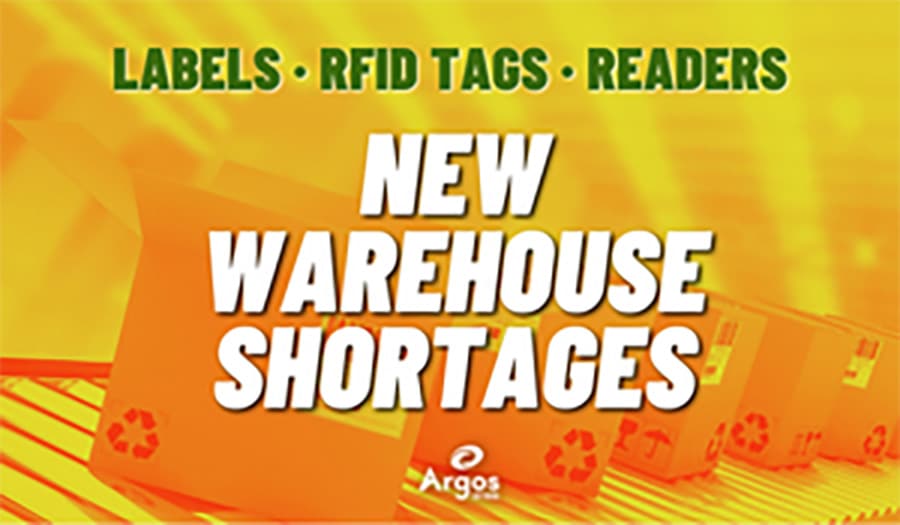
UPDATED 5/12/22
We all know that ongoing problems with supply chain replenishment and shortages still exist. This is a headache, not just for warehouses, but for all businesses across the board. To make a bad situation worse, now there are shortages of paper labels for shipping and product identification. In addition, there is a scarcity of supplies for both RFID (Radio Frequency Identification) embedded tags and handheld barcode readers. Let’s take a closer look at how these issues are impacting warehouses and manufacturers:
Labeling: A Sticky Situation
In distribution, printed labels include barcodes or specific text, and some are embedded with RFID technology. All are used for accurate product and skid identification. Many businesses are now dealing with label price increases and a shortage of labeling supplies. Finnish paper manufacturer UPM Raflatac, is a leading producer of release base paper (the liner paper from which labels are peeled) and face paper (the actual labels). At the beginning of 2022, UPM’s production and export of labels completely shut down, resulting in higher prices and shortages. This was the result of the Finnish Paperworkers Union going on strike and gaining substantial support from the Transport Workers’ Union (AKT), which is refusing to handle UPM shipments out of Finland’s ports. The strike ended April 23 after all parties approved settlement proposals.
An article from Supply Chain Brain notes that the Finnish strike is mostly affecting the United States, Europe, and other western markets. There have been a series of paper shortage issues prior to the strike caused by other factors. These include higher label demands as a result of COVID testing and vaccine labeling requirements, the Suez Canal blockage and congestion, weather issues where adhesive manufacturers are based, earlier pandemic shutdowns and restrictions, and paper pulp supply chain disruptions. The Finnish strike just adds more to the supply headache. Labels are a critical component in the warehousing industry and prices are already on the rise. Meanwhile, we all await the time when circumstances surrounding access to affordable labeling supplies will come to an end.
Chip Shortages for Readers and RFID Tags
Warehouses that use RFID embedded labels and tags are experiencing additional hardship because of the electronic chip shortage. RFID labels and tags use chips. While the global chip shortage isn’t breaking news to anyone, the fact that they are also used in RFID labels has not been prominent in the media. Manufacturers are still trying to fill chip backorders caused by pandemic shutdowns so distribution facilities continue to deal with barcode and RFID supply shortages.
Silicon wafers serve as a base on which electronic chips are placed. It’s important to note that manufacturers from Eastern Asia provide about 95% of the silicon wafers. Main global suppliers note that they will not be able to meet the current and growing demand until 2024. Unfortunately, the global expansion of chip manufacturing is a slow process and the expansions cannot be relied upon to fix the immediate problem. All major global producers are reportedly investing to increase capacity as a result of rising demand with more chips expected to enter the market in the next couple of years. A $20 billion Intel Corp. chip-making hub is currently under construction in Ohio with completion expected in 2025, according to an article from Bloomberg. Both Samsung Electronics Co. and Taiwan Semiconductor Manufacturing Co. are also expanding operations in the U.S. for additional chip production forecasted to start by the end of 2023.
Distribution facilities should take note: these high-demand chips are used in barcode readers as well as the equipment that reads RFID tags and RF labels. Warehouses are now finding it hard to find readers worldwide due to supply shortages from pandemic shutdowns and chip shortages. Many of the reader manufacturers are China-based or China-built and have continuously been filling high volumes of backorders as well. In addition, China is experiencing pandemic shutdowns again, adding even more strain to the supply of new reader orders.
Chasing Bargains Could Backfire
To keep disruptions or shortages at bay from your daily operations, your facility should continue to purchase from your current label supplier on a regular basis so you don’t ‘lose your spot’ to someone else experiencing the same issues. You should also work continuously with your barcode and RFID equipment suppliers to properly maintain your current readers to avoid the sudden need for any new equipment.
Have you been experiencing problems with label or reader shortages? Contact us and let us know!




